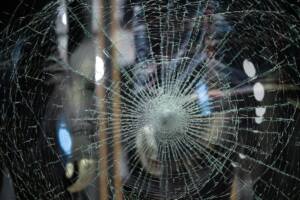Glass Analysis
 Trace evidence can be found at a crime scene in a number of different forms, including hairs and fibers, glass, or soil. Glass analysis includes determining the type of glass based on glass fragments. However, the entire fractured pane or window can be helpful when determining direction and sequence of force.
Trace evidence can be found at a crime scene in a number of different forms, including hairs and fibers, glass, or soil. Glass analysis includes determining the type of glass based on glass fragments. However, the entire fractured pane or window can be helpful when determining direction and sequence of force.
Glass type determinations: This type of determination compares a known sample to a glass fragment to see if the two samples came from the same source.
Glass can be made from a variety of different materials that differ from batch to batch. The presence of the different materials in the glass makes it easier to distinguish one sample from another. Also, the properties of glass can vary depending upon the temperature the glass is exposed to during manufacturing. Basic properties, such as color, thickness, and curvature, can also help to identify different samples of glass just by looking at them. Optical properties, such as refractive index (RI), are defined by various manufacturing methods. RI is the manner in which light passes through the glass. This can be measured easily even on small fragments of glass. These properties help to indicate that two samples of glass could be from the same source.
Direction of force determinations: This method determines which direction a projectile went through the glass by evaluating radial fractures in the glass fracture’s first concentric ring.
The determination of force direction is a process easily done by a crime scene technician. The purpose of this determination is to establish which direction the projectile went through the glass. The method used to establish this is the 4R Rule: Ridge lines on Radial fractures are at Right angles to the Rear.
The first step in this method is to find radial fractures that are within the first concentric fracture. Radial fractures are similar to the spokes of a wheel. Concentric fractures connect the radial fractures in a pattern similar to a spider web. The next step is to figure out which side of the fragment was facing in and which side was facing out. Contaminants or residues from the inside surface will feel different than the outside surface and are helpful in determining the sides.
Once the technician finds radial fracture and determines which side of the glass faced where, they must look at the broken edge of the glass. When a projectile strikes glass, it creates ridges called conchoidal fractures along the edge that are visible in profile. These conchoidal fractures are nearly parallel to the side in which force was applied (the direction which the projectile came from). The side of the glass opposite of the force is the rear of the glass; this is the side of the glass in which the conchoidal fractures lie at right angles.
Sequence of force determination: An examiner can establish the sequence of the shots by considering the radial fracture’s termination points. The first shot’s radial fractures will extend completely while the subsequent shots’ radial fractures will be stopped or cut off as they come into contact with prior fractures.
Glass analysis can be helpful in various ways. Glass fragments at a crime scene should always be collected and analyzed because several clues can be gathered about the events that occurred during the crime. Fragments of glass from headlights at a hit-and-run scene can leave clues about the unknown vehicle. Also, glass fragments can help police determine which direction the first bullet was fired through the glass. These clues can be gathered through the analysis of even the smallest fragments of glass.

